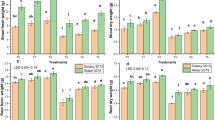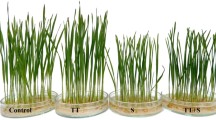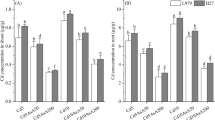Abstract
Cadmium (Cd) is a toxic metal and an environmental pollutant that significantly reduces plant growth and productivity. Proper management can ameliorate dysfunction and improve the plant growth and productivity exposed to Cd. Therefore, the present study was conducted to explore the protective role of the fungicides tebuconazole (TEB) and trifloxystrobin (TRI) in helping wheat (Triticum aestivum L. cv. Norin 61) seedlings to tolerate Cd. Five-day-old hydroponically grown seedlings were allowed to mild (0.25 mM CdCl2) and severe (0.5 mM CdCl2) Cd stress separately and with the fungicides (2.75 µM TEB + 1.0 µM TRI) for the next four days. Compared to control, the level of H2O2 in the seedlings exposed to mild and severe Cd stress alone increased by 81 and 112%, respectively. The accumulation of Cd also increased in the wheat seedlings along with declining mineral nutrients under Cd stress. The protective effect of TEB and TRI was observed with the enhancement of the antioxidant defense and methylglyoxalase systems and reduction in oxidative damage. Applying TEB and TRI reduced MDA (by 9 and 18%), EL (by 21 and 17%), MG (by 12 and 17%), and LOX activity (by 37 and 27%), respectively, relative to Cd stress alone. Cadmium uptake also decreased in the shoots (by 48 and 50%, respectively) and roots (by 23 and 25%, respectively) of the fungicide-treated wheat seedlings under mild and severe Cd stress, relative to stress alone. These results indicate the exogenous application of TEB and TRI is a promising approach to improve Cd tolerance in wheat plants. Further investigation is needed under field conditions and for other crop species to determine the Cd-tolerance induced by TEB and TRI application.






Similar content being viewed by others
References
Abbas T, Rizwan M, Ali S, Adrees M, Mahmood A, Zia-ur-Rehman M, Ibrahim M, Arshad M, Qayyum MF (2018) Biochar application increased the growth and yield and reduced cadmium in drought stressed wheat grown in an aged contaminated soil. Ecotoxicol Environ Saf 148:825–833
Addinsoft (2020) XLSTAT v. 2020.1.1: data analysis and statistics software for Microsoft Excel. Addinsoft, Paris
Barrs HD, Weatherley PE (1962) A re-examination of the relative turgidity technique for estimating water deficits in leaves. Aust J Biol Sci 15:413–428
Bashir A, Rizwan M, Ali S, Zia ur Rehman M, Ishaque W, Riaz MA, Maqbool A (2018) Effect of foliar-applied iron complexed with lysine on growth and cadmium (Cd) uptake in rice under Cd stress. Environ Sci Pollut Res 25:20691–20699
Bates LS, Waldren RP, Teari D (1973) Rapid determination of free proline for water stress studies. Plant Soil 39:205–207
Bhuyan MHMB, Parvin K, Mohsin SM, Mahmud JA, Hasanuzzaman M, Fujita M (2020) Modulation of cadmium tolerance in rice: insight into vanillic acid-induced upregulation of antioxidant defense and glyoxalase systems. Plants 9:188. https://doi.org/10.3390/plants9020188
Bradford MM (1976) A rapid and sensitive method for the quantitation of microgram quantities of protein utilizing the principle of protein-dye binding. Anal Biochem 72:248–254
Chen F, Wang F, Wu F, Mao W, Zhang G, Zhou M (2010) Modulation of exogenous glutathione in antioxidant defense system against Cd stress in the two barley genotypes differing in Cd tolerance. Plant Physiol Biochem 48:663–672
Diaz-Espejo A, Cuevas MV, Ribas-Carbo M, Flexas J, Martorell S, Fernández JE (2012) The effect of strobilurins on leaf gas exchange, water use efficiency and ABA content in grapevine under field conditions. J Plant Physiol 169:379–386
Dionisio-Sese ML, Tobita S (1998) Antioxidant responses of rice seedlings to salinity stress. Plant Sci 135:1–9
Doderer A, Kokkelink I, Van der Veen S, Valk B, Schram A, Douma A (1992) Purification and characterization of two lipoxygenase isoenzymes from germinating barley. Biochim Biophys Acta 112:97–104. https://doi.org/10.1016/0167-4838(92)90429-H
El-Shabrawi H, Kumar B, Kaul T, Reddy MK, Singla-Pareek SL, Sopory SK (2010) Redox homeostasis, antioxidant defense, and methylglyoxal detoxification as markers for salt tolerance in Pokkali rice. Protoplasma 245:85–96
Fletcher RA, Gill A, Davis TD, Sankhla N (2000) Triazoles as plant growth regulators and stress protectants. Hortic Rev 24:55–138
Gill SS, Anjum NA, Gill R, Yadav S, Hasanuzzaman M, Fujita M, Mishra P, Sabat SC, Tuteja N (2015) Superoxide dismutase—mentor of abiotic stress tolerance in crop plants. Environ Sci Pollut Res 22:10375–10394
Gill SS, Tuteja N (2010) Reactive oxygen species and antioxidant machinery in abiotic stress tolerance in crop plants. Plant Physiol Biochem 48:909–930
Gong Z, Li D, Liu C, Cheng A, Wang W (2015) Partial purification and characterization of polyphenol oxidase and peroxidase from chestnut kernel. LWT-Food Sci Technol 60:1095–1099
Grossmann K, Kwiatkowski J, Retzlaff G (1999) Regulation of phytohormone levels, leaf senescence and transpiration by the strobilurin kresoxim-methyl in wheat (Triticum aestivum). J Plant Physiol 154:805–808
Guo B, Liu C, Liang Y, Li N, Fu Q (2019) Salicylic acid signals plant defence against cadmium toxicity. Int J Mol Sci 20:2960. https://doi.org/10.3390/ijms20122960
Guo J, Zhou R, Ren X, Jia H, Hua L, Xu H, Lv X, Zhao J, Wei T (2018) Effects of salicylic acid, epi-brassinolide and calcium on stress alleviation and Cd accumulation in tomato plants. Ecotoxicol Environ Saf 157:491–496
Hameed A, Hameed A, Ahmad M, Farooq T (2020) Alleviation of cadmium toxicity by mercapto-triazole priming in wheat. Arch Agron Soil Sci 66:1467–1480
Hasanuzzaman M, Alam MM, Nahar K, Mohsin SM, Bhuyan MHMB, Parvin K, Hawrylak-Nowak B, Fujita M (2019a) Silicon-induced antioxidant defense and methylglyoxal detoxification works coordinately in alleviating nickel toxicity in Oryza sativa L. Ecotoxicology 28:261–276
Hasanuzzaman M, Bhuyan MHMB, Anee TI, Parvin K, Nahar K, Mahmud JA, Fujita M (2019b) Regulation of ascorbate-glutathione pathway in mitigating oxidative damage in plants under abiotic stress. Antioxidants 8:384. https://doi.org/10.3390/antiox8090384
Hasanuzzaman M, Bhuyan MHMB, Zulfiqar F, Raza A, Mohsin SM, Mahmud JA, Fujita M, Fotopoulos V (2020) Reactive oxygen species and antioxidant defense in plants under abiotic stress: revisiting the crucial role of a universal defense regulator. Antioxidants 9:681. https://doi.org/10.3390/antiox9080681
Hasanuzzaman M, Nahar K, Anee TI, Fujita M (2017) Exogenous silicon attenuates cadmium-induced oxidative stress in Brassica napus L. by modulating AsA-GSH pathway and glyoxalase system. Front Plant Sci. 8:1061. https://doi.org/10.3389/fpls.2017.01061
Hasanuzzaman M, Nahar K, Gill SS, Alharby HF, Razafindrabe BH, Fujita M (2017) Hydrogen peroxide pretreatment mitigates cadmium-induced oxidative stress in Brassica napus L.: an intrinsic study on antioxidant defense and glyoxalase systems. Front Plant Sci. https://doi.org/10.3389/fpls.2017.00115
Heath RL, Packer L (1968) Photoperoxidation in isolated chloroplast. I. Kinetics and stoichiometry of fatty acid peroxidation. Arch Biochem Biophys 125:189–198
Hossain MS, Abdelrahman M, Tran CD, Nguyen KH, Chu HD, Watanabe Y, Hasanuzzaman M, Mohsin SM, Fujita M, Tran LSP (2020) Insights into acetate-mediated copper homeostasis and antioxidant defense in lentil under excessive copper stress. Environ Pollut 258:113544. https://doi.org/10.1016/j.envpol.2019.113544
Hossain MS, Hasanuzzaman M, Sohag MMH, Bhuyan MHMB, Fujita M (2019) Acetate-induced modulation of ascorbate: glutathione cycle and restriction of sodium accumulation in shoot confer salt tolerance in Lens culinaris Medik. Physiol Mol Biol Plants 25:443–455
Ismael MA, Elyamine AM, Moussa MG, Cai M, Zhao X, Hu C (2018) Cadmium in plants: uptake, toxicity, and its interactions with selenium fertilizers. Metallomics 11:255–277
Khanna K, Jamwal VL, Kohli SK, Gandhi SG, Ohri P, Bhardwaj R, Abd-Allah EF, Hashem A, Ahmad P (2019) Plant growth promoting rhizobacteria induced Cd tolerance in Lycopersicon esculentum through altered antioxidative defense expression. Chemosphere 217:463–47
Köhle H, Grossmann K, Jabs T, Gerhard M, Kaiser W, Glaab J, Conrath U, Seehaus K, Herms S (2002) Physiological effects of the strobilurin fungicide F 500 on plants. In: Dehne H-W, Gisi U, Kuck KH, Russell PE, Lyr H (eds) Modern fungicides and antifungal compounds III. AgroConcept, Bonn, pp 61–74
Koller W (1987) Isomers of sterol synthesis inhibitors: fungicidal effects and plant growth regulator activities. Pesticide Sci 18:129–147
Kumar M, Chand R, Shah K (2016) Evidences for growth-promoting and fungicidal effects of low doses of tricyclazole in barley. Plant Physiol Biochem 103:176–182
Küpper H, Parameswaran A, Leitenmaier B, Trtilek M, Šetlík I (2007) Cadmium-induced inhibition of photosynthesis and long-term acclimation to cadmium stress in the hyperaccumulator Thlaspi caerulescens. New Phytolo 175:655–674
Lanier C, Bernard F, Dumez S, Leclercq-Dransart J, Lemière S, Vandenbulcke F, Nesslany F, Platel A, Devred I, Hayet A, Cuny D, Deram A (2019) Combined toxic effects and DNA damage to two plant species exposed to binary metal mixtures (Cd/Pb). Ecotoxicol Environ Saf 167:278–287
Law MY, Charles SA, Halliwell B (1983) Glutathione and ascorbic acid in spinach (Spinacia oleracea) chloroplasts. The effect of hydrogen peroxide and of paraquat. Biochem J 210:899–903
Lichtenthaler HK (1987) Chlorophylls and carotenoids: pigments of photosynthetic biomembranes. In: Packer L, Douce R (eds) Methods in enzymology. Academic Press, Cambridge, pp 350–382
Mahmud JA, Hasanuzzaman M, Nahar K, Bhuyan MHMB, Fujita M (2018) Insights into citric acid-induced cadmium tolerance and phytoremediation in Brassica juncea L.: coordinated functions of metal chelation, antioxidant defense and glyoxalase systems. Ecotoxicol Environ Saf 147:990–1001
Mohsin SM, Hasanuzzaman M, Bhuyan MHMB, Parvin K, Fujita M (2019) Exogenous tebuconazole and trifloxystrobin regulates reactive oxygen species metabolism toward mitigating salt-induced damages in cucumber seedling. Plants 8:428. https://doi.org/10.3390/plants8100428
Mohsin SM, Hasanuzzaman M, Nahar K, Hossain MS, Bhuyan MHMB, Parvin K, Fujita M (2020) Tebuconazole and trifloxystrobin regulate the physiology, antioxidant defense and methylglyoxal detoxification systems in conferring salt stress tolerance in Triticum aestivum L. Physiol Mol Biol Plants 26:1139–1154
Mohsin SM, Hasanuzzaman M, Parvin K, Fujita M (2020) Pretreatment of wheat (Triticum aestivum L.) seedlings with 2, 4-D improves tolerance to salinity-induced oxidative stress and methylglyoxal toxicity by modulating ion homeostasis, antioxidant defenses, and glyoxalase systems. Plant Physiol Biochem 152:221–231
Nahar K, Hasanuzzaman M, Alam MM, Rahman A, Suzuki T, Fujita M (2016) Polyamine and nitric oxide crosstalk: antagonistic effects on cadmium toxicity in mung bean plants through upregulating the metal detoxification, antioxidant defense and methylglyoxal detoxification systems. Ecotoxicol Environ Saf 126:245–255
Nahar K, Rahman M, Hasanuzzaman M, Alam MM, Rahman A, Suzuki T, Fujita M (2016) Physiological and biochemical mechanisms of spermine-induced cadmium stress tolerance in mung bean (Vigna radiata L.) seedlings. Environ Sci Pollut Res 23:21206–21218
Najmanova J, Neumannova E, Leonhardt T, Zitka O, Kizek R, Macek T, Mackova M, Kotrba P (2012) Cadmium-induced production of phytochelatins and speciation of intracellular cadmium in organs of Linum usitatissimum seedlings. Ind Crop Prod 36:536–542
Nakano Y, Asada K (1981) Hydrogen peroxide is scavenged by ascorbate-specific peroxidase in spinach chloroplasts. Plant Cell Physiol 22:867–880
Ni J, Wang Q, Shah FA, Liu W, Wang D, Huang S, Fu S, Wu L (2018) Exogenous melatonin confers cadmium tolerance by counterbalancing the hydrogen peroxide homeostasis in wheat seedlings. Molecules 23:799. https://doi.org/10.3390/molecules23040799
Norková R, Dytrtová JJ, Jakl M, Schröder D (2012) Formation of tebuconazole complexes with cadmium (II) investigated by electrospray ionization mass spectrometry. Water Air Soil Pollut 223:2633–2640
Parvin K, Hasanuzzaman M, Bhuyan MHMB, Mohsin SM, Fujita M (2019) Quercetin mediated salt tolerance in tomato through the enhancement of plant antioxidant defense and glyoxalase systems. Plants 8:247. https://doi.org/10.3390/plants8080247
Parvin K, Nahar K, Hasanuzzaman M, Bhuyan MHMB, Mohsin SM, Fujita M (2020) Exogenous vanillic acid enhances salt tolerance of tomato: insight into plant antioxidant defense and glyoxalase systems. Plant Physiol Biochem 150:109–120
Purohit S, Singh VP (1999) Uniconazole (S-3307) induced protection of Abelmoschus esculentus L. against cadmium stress. Photosynthetica 36:597–599
Rahman A, Nahar K, Hasanuzzaman M, Fujita M (2016) Manganese-induced cadmium stress tolerance in rice seedlings: coordinated action of antioxidant defense, glyoxalase system and nutrient homeostasis. C R Biol 339:462–474
Raza A, Habib M, Kakavand SN, Zahid Z, Zahra N, Sharif R, Hasanuzzaman M (2020) Phytoremediation of cadmium: physiological, biochemical, and molecular mechanisms. Biology 9:177. https://doi.org/10.3390/biology9070177
Rizwan M, Ali S, Ali B, Adrees M, Arshad M, Hussain A, Zia ur Rehman M, Waris AA (2019) Zinc and iron oxide nanoparticles improved the plant growth and reduced the oxidative stress and cadmium concentration in wheat. Chemosphere 214:269–277
Ruske RE, Gooding MJ, Dobraszczyk BJ (2004) Effects of triazole and strobilurin fungicide programmes, with and without lateseason nitrogen fertiliser, on the baking quality of Malacca winter wheat. J Cereal Sci 40:1–8
Sauter H (2007) Fungicides acting on oxidative phosphorylation. In: Schirmer KW (ed) Modern crop protection compounds. Wiley, Weinheim, pp 457–495
Singh VP (1993) Uniconazole (S-3307) induced cadmium tolerance in wheat. J Plant Growth Regul 12:1–3
Susana MG, Liliana BP, Roberto AB, Claudia EA, María FI, Eliana PR, Myriam SZ, María DG, María PB (2012) Unravelling cadmium toxicity and tolerance in plants: insight into regulatory mechanisms. Environ Exp Bot 83:33–46
Sytar O, Kumar A, Latowski D, Kuczynska P, Strzałka K, Prasad MNV (2013) Heavy metal-induced oxidative damage, defense reactions, and detoxification mechanisms in plants. Acta Physiol Plant 35:985–999
Thomas RM, Singh VP (1996) Reduction of cadmium-induced inhibition of chlorophyll and carotenoid accumulation in Cucumis sativus L. by uniconazole (S3307). Photosynthetica 32:145–148
Wei T, Lv X, Jia H, Hua L, Xu H, Zhou R, Zhao J, Ren X, Guo J (2018) Effects of salicylic acid, Fe (II) and plant growth-promoting bacteria on Cd accumulation and toxicity alleviation of Cd tolerant and sensitive tomato genotypes. J Environ Manag 214:164–171
Wu YX, Von-Tiedemann A (2001) Physiological effects of azoxystrobin and epoxiconazole on senescence and the oxidative status of wheat. Pestic Biochem Physiol 71:1–10
Xue ZC, Gao HY, Zhang LT (2013) Effects of cadmium on growth, photosynthetic rate and chlorophyll content in leaves of soybean seedlings. Biol Plant 57:587–590
Zasoski RJ, Burau RG (1977) A rapid nitric-perchloric acid digestion method for multi-element tissue analysis. Commun Soil Sci Plant Anal 8:425–436
Zhang YJ, Zhang X, Chen CJ, Zhou MG, Wang HC (2010) Effects of fungicides JS399-19, azoxystrobin, tebuconazloe, and carbendazim on the physiological and biochemical indices and grain yield of winter wheat. Pestic Biochem Physiol 98:151–157
Zhu H, Ai H, Cao L, Sui R, Ye H, Du D, Sun J, Yao J, Chen K, Chen L (2018) Transcriptome analysis providing novel insights for Cd-resistant tall fescue responses to Cd stress. Ecotoxicol Environ Saf 160:349–356
Acknowledgments
This study was funded by the Ministry of Education, Culture, Sports, Science and Technology (MEXT), Japan. Thanks to Dennis Murphy, Ehime University, Japan for English language correction of the manuscript.
Author information
Authors and Affiliations
Contributions
SMM designed, conceived, and executed the experiment and drafted the manuscript; MH designed the experiment, analyzed the data, and edited the manuscript; KP and MSH actively participated in the experiment; MF supervised the experiment, and edited and reviewed the manuscript.
Corresponding author
Ethics declarations
Conflict of interest
The authors declare that the research was conducted without any commercial or financial relationships that could be construed as a potential conflict of interest.
Additional information
Publisher's Note
Springer Nature remains neutral with regard to jurisdictional claims in published maps and institutional affiliations.
Rights and permissions
About this article
Cite this article
Mohsin, S.M., Hasanuzzaman, M., Parvin, K. et al. Protective role of tebuconazole and trifloxystrobin in wheat (Triticum aestivum L.) under cadmium stress via enhancement of antioxidant defense and glyoxalase systems. Physiol Mol Biol Plants 27, 1043–1057 (2021). https://doi.org/10.1007/s12298-021-00983-7
Received:
Revised:
Accepted:
Published:
Issue Date:
DOI: https://doi.org/10.1007/s12298-021-00983-7




